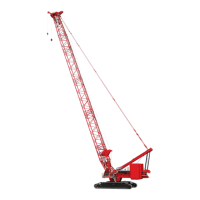OPERATING CONTROLS AND PROCEDURES MLC90A-1/MLC100-1 OPERATOR MANUAL
3-46
Published 12-10-19, Control # 258-05
SHUTDOWN PROCEDURE OR LEAVING
THE CRANE UNATTENDED
1. Travel the crane onto a level surface. Do not leave the
crane unattended on a grade.
2. Turn on the travel park switch.
3. Swing the rotating bed to the desired position. Then turn
on the swing park switch.
4. Lower all loads to the ground.
5. Turn on the drum park switch for each load drum.
6. If possible, lower the boom and jib (if equipped) onto
blocking at ground level.
If the boom cannot be lowered, as determined by a
qualified designated person, it must be securely
fastened from movement by the wind or other outside
forces.
Refer to the wind conditions in the Wind Conditions chart
for operating restrictions under various wind conditions.
NOTE The qualified designated person must be familiar
with the job site limitations, the crane configuration,
and the expected weather conditions.
7. Check that all the control handles are in the off position.
8. Decrease engine speed to idle. Allow the engine to idle
for three to five minutes so it cools evenly.
9. Stop the engine.
10. Remove all keys from the cab to prevent unauthorized
operation.
11. Lock the operator cab windows and door to prevent
unauthorized entry.
LOW CLEARANCE TRAVEL OPTION
To provide low clearance, the this can be traveled with the
gantry down when equipped with the optional tie-down links
and hardware identified in Figure 3-19 on page 3-46
and
Figure 3-20 on page 3-48.
Low Clearance Travel Boom Configurations
Low clearance travel is allowed for the following boom
configurations:
Fully Rigged Boom
See Figure 3-19 on page 3-46.
• Series 1 or 2 counterweight (1) installed.
• A maximum boom length (2) of 19 m (62.3 ft) fully
assembled in proper sequence according to the Boom
Rigging Drawing. See Section 4 of the Operator Manual
for detailed assembly instructions.
• Appropriate length of boom pendants (3) installed and
connected to the boom top and equalizer (4). See
Section 4 of the Operator Manual for detailed assembly
instructions.
• Equalizer UNPINNED from the boom butt.
• Gantry (5) lowered and pinned to the crane counter-
weight.
Cantilevered Boom Inserts
See Figure 3-20 on page 3-48.
• Series 1 or 2 counterweight (1) installed.
• A maximum boom length (2) of 27 m (88.6 ft), to include
boom butt, fully assembled in proper sequence
according to the Boom Rigging Drawing. See Section 4
of the Operator Manual for detailed assembly
instructions. See Table 3-13 on page 3-50
for insert
limitations.
• Boom pendants removed.
• Equalizer (4) PINNED to the boom butt.
• Gantry (5) lowered and pinned to the crane counter-
weight.
Low Clearance Travel Limitations
For low clearance travel:
• The crane must be operated on a firm uniformly
supporting surface.
• The upperworks must be in line with the lowerworks and
grade when grade exceeds 1% (0.5°). Swing is
prohibited.
• The boom angle must be limited to horizontal (0°) and
not more than 2° above horizontal.
• The grade in the direction of travel must not exceed 5%
(2.9°).
• The grade from side to side must not exceed 2% (1.1°)
measured at the boom hinge pins.
• The crane must be traveled slowly and smoothly to
avoid shock loading the boom and rigging.
WARNING
Moving Load/Tipping Crane Hazard
The operator shall not leave the operator cab until the
crane, loads, and boom have been secured against
movement.
Changing weather conditions including but not limited to
— wind, ice or snow accumulation, precipitation, flooding,
lightning, etc. should be considered when determining the
location and configuration of the crane when it will be left
unattended.

